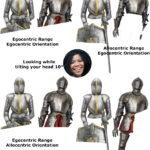Spatial Neglect

You fail to recognize one side of the objects that you perceive. This may mean that you only see objects in half of your sensory field, or you only notice half of each object. Roll or choose to determine the type, range, axis, and orientation.
- Type. Your neglect is equally likely input or output. Neglect of input includes ignoring half of all of what your five basic senses perceive, including what you imagine, remember, dream, or hallucinate. You have a −(IE) penalty on all Wisdom (Perception) checks on the affected half. Neglect of output prevents you from using your body on the half, either using those limbs or ability to interact with objects on the neglected side, regardless which limb you’re using. You have a −(IE) penalty on all rolls affecting manipulating the neglected side, whether through physical or magic interaction. Spells with somatic components usually need to be modified to work within your physical range, requiring a day for every hour normally needed to inscribe into your spellbook and double the cost due to experimentation materials.
- Range. You neglect either the entire half of your field of perception (egocentric; e.g., you don’t notice a map on your left side.) or half of each individual item (allocentric; e.g., you don’t notice the left side of a map, even though the entire map is to your right.) If you have an egocentric range, you have a −(IE) penalty to your Armor Class and reactions to enemies on the neglected side. If you have an allocentric range, you have a −(IE) penalty to your Armor Class and reactions to enemies when the attack comes from the neglected side of their bodies. Depending on your orientation, the player and GM will need to determine how spells can be read from a spellbook, such as writing vertically or diagonally or using an encoded alphabet or language where all letters are symmetrical, or where words are palindromes or written as compound words.
- Axis. You neglect half of your perceptive field. Choose or roll on the following table.
1d10 Neglected Half 1–4 Left 5–8 Right 9 Top 10 Bottom - Orientation. Your frame of reference to determine which half you neglect is either egocentric (relative to your field of view) or allocentric (relative to the object’s perceived side). (e.g., If you have an egocentric range but an allocentric orientation, the neglected side remains the same regardless of your head or body position. If you have an allocentric range and an egocentric orientation, the missing half of each object does not change even if the object is tilted.)
As a side effect of all forms of this condition, you have a +(IE) on rolls to hit a target with a displacement feature, although if you have an allocentric range, you have a −(IE) penalty to your Armor Class against one or more of its limbs or tentacles, depending on your axis.
Note that this affects all forms of perception whether natural or magical, including scrying, detection spells, or other perceptive effects.
For those without this trait who would like to implement it in-game, note that you’ll likely more easily implement one of the Egocentric Orientation options, as they’re generally more intuitive to those without this condition.
Real-world Examples
Hemispatial Neglect, Somatoparaphrenia, Hypokinesia
Assistive Options
Depending on the variety of neglect, you depend on your allies to communicate to you what you can’t perceive. If an ally uses their action to verbally guide you, the IE of most actions will be reduced by 1 for that action. This assistance can also be used for bonus actions but not reactions.